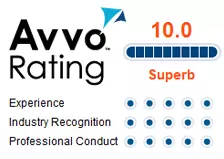In Michigan, if you are arrested for drunk driving and refuse the “evidentiary” breath test, that is the test that you are requested to take at the police station or jail AFTER you’ve been arrested, then a warrant will almost certainly be obtained to draw your blood. In most instances you will be taken to a hospital for the blood draw.
At the hospital the arresting officer will supply to the person drawing your blood a small white box containing most of what is necessary to complete the blood draw. These boxes are called “blood draw kits” and are used specifically to draw blood in the context of a drunk driving case.
These blood draw kits all contain the same things, in other words, they are standardized meaning that all agencies across the State of Michigan use the exact same blood draw kits. These kits are supplied to each state and local law enforcement agency by the State Police. The State Police orders them from a company called Tri-Tech Inc.
The blood draw kits used here in Michigan were specially designed for use in drunk driving investigations according to the specifications supplied by the State Police forensic lab. Inside the blood draw kit are two grey stopper vials into which your blood will be drawn. The blood vials are supplied by a different company by the name of BDvacutainer.
After the blood draw is completed, the blood draw kit containing two vials of your blood will be sent to the forensic laboratory in Lansing Michigan. This is the only place the blood collected for a drunk driving investigation will be tested. After about 7-10 days your blood will be tested for alcohol content, and the results sent back to the arresting agency. From there your attorney will eventually obtain a copy of the laboratory report.
The blood vials inside these Tri-Tech kits contain two chemicals or salts. These salts are a preservative and an anticoagulant. It is not completely unusual for the law enforcement agency to use a kit that is expired. Expiration dates are not noted anywhere on the laboratory documents. The only way to know this is for your attorney to cross-examine the people involved in handling the blood, and hope that they are honest, or to inspect the vials themselves.
If the kits were expired, and your attorney finds out, then the people at the forensic laboratory will testify that it doesn’t matter because salts are inert, meaning nothing happens to them over time. Time does not cause the salts to degrade. But is this true?
The literature from the manufacturer, BDvacutainer, suggests otherwise. It indicates as follows:
Storage:
Store tubes at 4-25 deg C (39-77 F), unless otherwise noted on the page label. All liquid preservatives and anticoagulants are clear and colorless, except CTAD which is yellow. Do not use if they are discolored or contain precipitates. Powered and freeze-dried additives such as heparin and thrombin are white; fluoride and fluoride/oxalate may be pale pink. Do not use if color has changed. Do not use tubes after their expiration date.
So, who’s correct and who’s not? Most judges and prosecutors would leave that question up the jury. But, when a person’s liberty is being decided, is this appropriate? Should we as a society give such leeway to the forensic labs? And, should the laboratory personnel offering this testimony have an obligation to answer questions more forthrightly?
The following state is contained in a February 18, 2009 press release issued by The National Academies. The title of the press release is:
‘BADLY FRAGMENTED’ FORENSIC SCIENCE SYSTEM NEEDS OVERHAUL; EVIDENCE TO SUPPORT RELIABILITY OF MANY TECHNIQUES IS LACKING”
Court Testimony Should Be Grounded in Science, Acknowledge Uncertainties
The committee was not asked to determine whether analysis from particular forensic science methods should be admissible in court, and did not do so. However, it concluded that the courts cannot cure the ills of the forensic science community. “The partisan adversarial system used in the courts to determine the admissibility of forensic science evidence is often inadequate to the task,” said Edwards. “And because the judicial system embodies a case-by-case adjudicatory approach, the courts are not well-suited to address the systemic problems in many of the forensic science disciplines.”
The committee also concluded that two criteria should guide the law’s admission of and reliance upon forensic evidence in criminal trials: the extent to which the forensic science discipline is founded on a reliable scientific methodology that lets it accurately analyze evidence and report findings; and the extent to which the discipline relies on human interpretation that could be tainted by error, bias, or the absence of sound procedures and performance standards.
The report points out the critical need to standardize and clarify the terms used by forensic science experts who testify in court about the results of investigations. The words commonly used — such as “match,” “consistent with,” and “cannot be excluded as the source of” — are not well-defined or used consistently, despite the great impact they have on how juries and judges perceive evidence.
Regarding blood test evidence used in support of drunk driving charges in Michigan, the question that remains is whether or not there should be more scrutiny and independent verification to prevent abuses similar to what occurred in the State of Washington. It is our opinion that the answer is most assuredly “yes.” This is in part due to the fact that laboratories across the country are under siege due to bad science, but also due in part to the information discussed above as well as elsewhere in this web site.
If you think you are the victim of bad science in a drunk driving case then you should first discuss these issues with your lawyer. If your lawyer seems to dismiss your concerns or not even understand the issues, then you may want to consider finding a lawyer that specializes in drunk driving defense.




{ 1 comment… read it below or add one }
The following has been drafted to address this issue. I have 2 power point slide not included. Please send email request for sllides (I’ve had technical problems grouping graphic contents).
June 16, 2009
Dear Michigan Litigator:
Michigan statutes (MCL 600.2955) and rules of evidence (MRE 702 and 703) require expert reporting to include established, peer reviewed methods and Error Rates to demonstrate relevant and reliable evidence. Current and past Michigan State Police Forensic Lab gas chromatography – headspace BAC method and reporting practices (MSP, 2006) violate these requirements by implementing contraindicated techniques and biased reporting. Specifically misleading BAC analytical interpolation and unethical MSP practices are delineated below. These facts may be applicable to your current and/or past cases. Recently the U.S. Senate and House of Representatives initiated via the National Academy of Sciences a critical review of such forensic toxicology practices (http://www.nap.edu/catalog/12589.html). KETox presents these offensive MSP GC-HS BAC issues to address your current and past client’s forensic issues.
The MSP contraindicated and biased practices include:
I. MSP’s GC-HS BAC (2006) pretreatment step (2.1.5.1) involves the butyl rubber septa (BRS) contact with blood + internal standard:
A. BRS use for measuring BAC is explicitly contradicted within MSP’s cited reference (Seto, 1994).
B. BRS preferentially adsorbs IS, i.e., 1-propanol (GC5) or t-butanol (GC6)) causing serious analytical errors and mistaken BAC interpolations.
C. Fig. 1 graphically illustrates how the use of BRS can incorrectly interpolate (i.e., horizontal intercept with vertical arrows, point B) your client’s actual BAC (point A).
1. BRS preferentially adsorbs IS to reduce its detected signal that then elevates the [Esignal/ISsignal] ratio and mistakenly interpolates your client’s BAC.
II. MSP GC-HS fails to provide characterized Error Rates for single GC-HS Aqueous Ethanol Standards, NIST AES and Blood Controls for unbiased, random errors required for statistical control in BAC expert report per Daubert (Langhofer, 2004).
A. MSP (2006) Inferred vs. Observed GC-HS BAC Analysis :
1. GC-HS weekly calibration purposefully or unwittingly applies AES + IS and Linear Regression Analysis, (Fig. 2) [E]/[IS] v [E gm/dL], that deceptively looks better than the observed data.
a. MSP’s LRA graphically designates individual AES points derived from the resulting equation (Fig. 2) and fail to provide the observed GC-HS [E]/[IS] points and their variances that would describe individual BAC’s accuracy with Upper/Lower Error Limits (blue dashed lines). The depicted 8 exact line points is as impossible as 8 flips of a coin yielding 8 consecutive head observations!
b. MSP’s designated AESs optimize accuracy at 0.192 gm/dL (Draper, 1998) and become progressively larger above and below this point. Why isn’t maximum accuracy at 0.080 gm/dL?
c. The Lower and Upper Error Limits assure the accuracy of each measured BAC based on the methods characterization calibration Error Rate for each AES. In lieu of MSP’s AES ER, Fig 2 graphically illustrates the Upper (0.39 gm/dL) and Lower (0.25 gm/dL) accuracy range for an interpolated BAC of 0.32 gm/dL. Without GC-HS ER it is impossible to evaluate your client’s GC-HS BAC. Similarly for 0.080, the LEL is not intersected, cannot be demonstrated, and UEL exceeds 0.110!
d. MSP’s reported R2 (coefficient of determination ) always approximates ~ 1.0 and an apparent intercept at origin, i.e., – 0.0017. R2 = 0.9998 suggests a perfect correlation that is influenced by the designated AES.
1) MSP’s LRA excludes the highly variable 0.000 and 0.012, and includes low variance AESs of comatose, 0.393, and lethal, 0.59 gm/dL, BACs. MSP’s designated AES bias R2 ~ 1, inherently minimizes accuracy in critical sobriety testing ranges, i.e., 0.020, 0.040 and 0.080 gm/dL, and misleads its judicial BAC reporting.
2. MSP Daily GC-HS calibration checks (2.1.5, Method) for AES [E]/[IS] and interpolated NIST AES, and blood controls depend on their Acceptance Criteria established by GC-HS method calibration and characterization ER (item II.A.1). This warrants GC-HS interpolation of your client’s BAC but these critical Acceptance Criteria are not established nor provided per FOIAs.
The data presented above were derived from available data in FOIAs from MSP and the documented MSP GC-HS Method (MSP, 2006). The critique is based on cited reference within MSP (2006), industry accepted practices (Taylor, 1987; Jones and Liddicoat, 2009), and the intentions outlined by the National Academy of Sciences to improve forensic science. Comments are directed at the underpinnings of the GC-HS analytical process, and for the benefit of the MSP GC-HS method in reporting relevant and reliable BACs for critical judicial decision making processes.
Works Cited
Draper, N. S. (1998). Applied Regression Analysis. New York: Wiley.
Jones, G.R., Liddicoat, L. (2009). Quality Assurance, in Garriott’s Medicolegal Aspects of Alcohol, 5th ed. Garriott J.C. (ed). pp 269-274. Lawyers & Judges Publishing, Tuscon.
Langhofer, R. (2004). Michigan adopts Daubert Principles and evidence-based expert testimony, Revised MRE 702 and 703. Michigan Bar Journal , 34 – 37.
MSP. (2006). Michigan State Police Crime Lab, 2.0 Alcohol Protocol.
Seto, Y. (1994). Determination of volatile substances in biological samples by headspace gas chromatography. J. Chromatogr. A , 674, 25-62.
Taylor, J. (1987). Control Charts. In J. Taylor, Quality Assurance of Chemical Measurements. Chelsea, MI: Lewis Publisher.